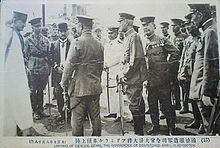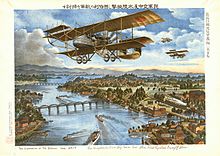Siberian intervention
The Siberian Intervention ( Japanese シ ベ リ ア 出兵 , Shiberia Shuppei ) is the term used to describe the sending of troops of the Imperial Japanese Army to the Russian Primorye region between 1918 and 1922 . It was part of an intervention by the Entente Powers in the Russian Civil War to support the White Army in its fight against the Bolshevik Red Army .
background
After the October Revolution in 1917, the Bolsheviks concluded a separate peace with the German Reich . The subsequent collapse of the Eastern Front posed an enormous problem for the Entente , not only because the German Reich was now able to relocate its troops from the Eastern to the Western Front , but also because it now had the opportunity to acquire large amounts of war material, the had accumulated at Murmansk , Arkhangelsk and Vladivostok . In addition, the 40,000 to 50,000 strong Czechoslovak legions were now trapped behind the enemy lines and tried to fight their way along the Trans-Siberian railway line to the east, towards Vladivostok.
Because of this situation, Great Britain and France decided to intervene against the Bolshevik government in the Russian Civil War. They hoped to achieve the following three goals:
- Prevent Allied war material from falling into German hands in Russia.
- Liberation of the Czechoslovak legions and their return to the European front.
- Reestablishment of the Eastern Front by installing a government with the support of the White Army.
Because of the shortage of soldiers, Great Britain and France asked the US to send troops to one intervention in northern Russia and another in Siberia. In 1918, President Woodrow Wilson decided , against the advice of the American War Department, to deploy 5,000 soldiers as the North Russia Expeditionary Force (also known as the Polar Bear Expedition ), and another 10,000 as the American Expeditionary Force Siberia .
Japanese participation
In July 1918 President Wilson requested 7,000 soldiers from the Japanese government as part of an international coalition of 25,000 soldiers in support of the American expeditionary forces in Siberia. After a heated debate in the Japanese parliament , the government of Japanese Prime Minister Terauchi Masatake approved the deployment of 12,000 soldiers, but on the condition that they were under Japanese command, i.e. not as part of an international coalition.
As a result of this political decision, the Imperial Japanese Army , led by Chief of Staff Mitsue Yui , acted independently. By November 1918, under the command of General Ōtani Kikuzo, more than 70,000 Japanese soldiers had occupied all ports and major cities in the Russian province of Primorye and eastern Siberia .
After the capture and execution of the leader of the White Army, Kolchak , by the Red Army and the evacuation of the Czechoslovak legions, the Americans and their allies withdrew from Vladivostok in June 1920. However, the Japanese stayed behind on the Japanese border for fear of further spreading communism . They supported the newly founded coastal republic .
The continued Japanese presence worried the US , which suspected Japan of having more extensive territorial plans for Siberia and the Russian Far East. The government under Prime Minister Katō Tomosaburō finally withdrew the Japanese soldiers in October 1922, after the coastal republic withdrew, exposed to intense diplomatic pressure from the USA and Great Britain and in the face of growing opposition in their own country because of the high costs both economically and in terms of people In early 1922 the People's Revolutionary Army of the Far Eastern Republic had pushed back to Vladivostok.
The consequences
The motives that Japan pursued with the intervention in Siberia were complex and difficult to understand. Officially, it was said that Japan, like the USA and the other nations of the coalition troops, was only going to Siberia to secure the war material there and "save" the Czechoslovak legions. But also the intense hostility of the Japanese government towards communism, the urge to compensate for historical losses to Russia, and the supposedly good opportunity to solve the “northern problem” for the security of Japan through the formation of a buffer state or through direct territorial expansion other factors. After the Red Army emerged victorious from the civil war, diplomatic relations between Japan and the Soviet Union were severely strained due to Japan's support for various leaders of the “white movement”.
On the Japanese side, 5,000 people died from acts of war or disease during the Siberian expedition, and spending exceeded 900 million yen .
See also
literature
- John Albert White: The Siberian Intervention . Princeton University Press, Princeton NJ 1950.
Web links
- WWI Siberian Diary , by WC Jones, 2nd Lt. US Army Russian Railway Service
- Paul Dunscomb: Siberian Intervention 1918-1922 , in: 1914-1918-online . International Encyclopedia of the First World War, ed. By Ute Daniel, Peter Gatrell, Oliver Janz, Heather Jones, Jennifer Keene, Alan Kramer, and Bill Nasson, issued by Freie Universität Berlin, Berlin 2018. doi : 10.15463 / ie1418.11306 .

